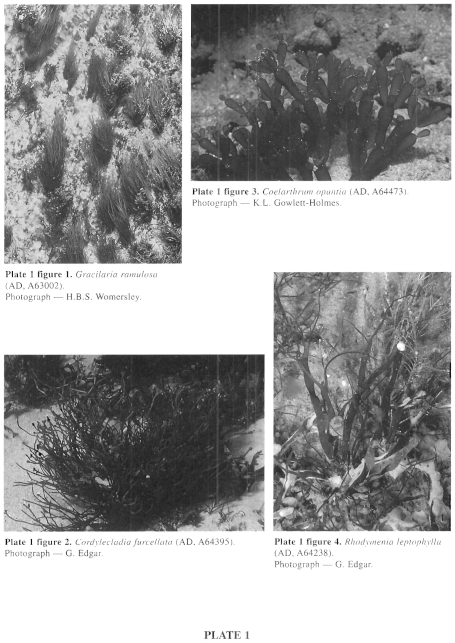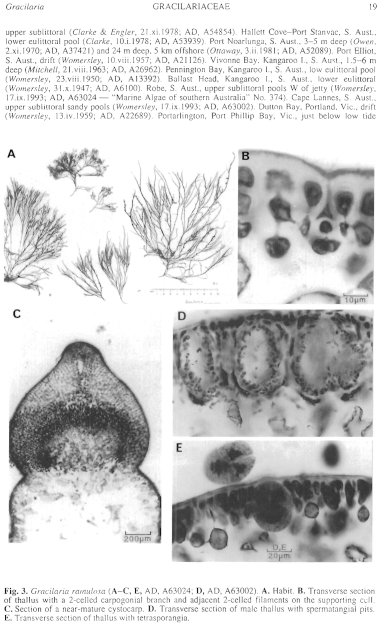|
|
|
|
|
|||||||||||
|
Electronic Flora of South Australia Species Fact Sheet
Phylum Rhodophyta – Class Florideophyceae – Order Gracilariales – Family Gracilariaceae
Selected citations: De Toni 1900b: 439. Sonder 1881: 22.
Synonyms
Gracilaria furcellata Harvey 1863: pl. 286. J. Agardh 1876: 419; 1901: 60. Chapman 1979: 301, pl. 109. De Toni 1900b: 441. May 1948: 53, fig. 9, pl. 14 fig. 2; 1965: 392. Sonder 1881: 22. Tisdall 1898: 508. Wilson 1892: 176. Womersley 1950: 169; 1966: 147.
NON G. furcellata (Montagne) Zanardini 1858: 266 [= Sarconema filiforme (Sonder) Kylin].
Gracilaria furcellata f. ramulosa (J. Agardh) May 1948: 56, pl. 14 fig. 2. Gracilaria sp. Harvey 1855a: 551; 1863, synop.: xxxiv.
Gracilaria cliftonii Withell, Millar & Kraft 1994: 285, figs 4, 5.
Gracilaria secundata sensu Womersley 1966: 147.
Thallus (Fig. 3A) medium to dark red-brown, fading to yellow-red, cartilaginous, usually densely tufted, 5–25 cm high, mostly subdichotomously branched and often more or less of even height, sometimes with longer, laterally (slightly secundly) branched, extended branches, more rarely with occasional to plentiful short lateral branches; branch apices sometimes shortly multifid (following grazing?). Branches terete to slightly compressed (when dry), 400–700 µm in diameter near apices, (600–) 800–1300 µm in mid to lower parts of most plants, becoming thickened and 1–2 mm in diameter near bases of single axis plants (second year?). Holdfast discoid, with one to (usually) several fronds, 4–12 mm across; epilithic. Structure pseudoparenchymatous (Fig. 3E), grading in cell size from the outer cortex to the large inner medullary cells, cortex 2–4 cells thick, outer cells rounded to angular in surface view and 5–12 µm across, L/D 1–1.5 in section of thallus, in young parts with elongate-ovoid to conical hair basal cells 10–15 µm in diameter; medulla 8–15 (–30) cells across, inner medullary cells ovoid, usually 100–200 µm in diameter, with numerous prominent secondary pit-connections; walls of inner cells 8–20 (–30) µm thick. Base of single axes thickened, with the outer cortical cells becoming meristematic to form long, tightly packed, filaments of small cells. Rhodoplasts discoid, sometimes in chains or ribbon like in medullary cells.
Reproduction: Gametangial thalli usually dioecious. Carpogonial branches (Fig. 3B) 2-celled, borne on an inner cortical (supporting) cell bearing also two 2-celled filaments. Carposporophytes (Fig. 3C) with a small rounded to lobed basal fusion cell, a dense pseudoparenchymatous mass of large-celled gonimoblast filaments (cells ovoid, 20–50 µm in diameter, L/D 1.5–3) which when well developed may have 2–4 deep lobes, bearing an upper zone of slender, small-celled, filaments producing terminal, subspherical to ovoid, carposporangia 15–35 µm in diameter, subterminal cells later maturing as carposporangia; traversing nutritive cells rare to common, mainly at the base of the carposporophyte where they may be single celled or involve fusion of several pericarp cells, often also from the upper gonimoblast to the pericarp. Cystocarps sessile and hemispherical when young, becoming subspherical and basally constricted, 1–2 mm in diameter; pericarp (Fig. 3C) massive, 200–400 µm thick with anticlinal rows of 10–15 (–20) cells with lateral pit-connections (becoming stellate), ostiolate and sometimes beaked; a slight inner pericarp of small cells usually present. Spermatangia (Fig. 3D) in ovoid pits 22–60 µm in diameter, cut off from lining cells, 2–5 µm in diameter.
Tetrasporangia (Fig. 3E) scattered, usually densely, in the cortex, basally pit-connected 2–5 cells deep, ovoid, 30–60 µm long and 20–50 µm in diameter, cruciately or decussately divided.
Type from King George Sound, W. Aust. (Harvey, Alg. Aust. Exsicc. 324B); holotype in Herb. Agardh, LD, 29286; isotype in MEL, 629924 (excl. right hand specimen).
Selected specimens: Cottesloe, W. Aust., drift (Smith, April 1945; AD, A2136). Point Peron, W. Aust., reef pools (Mitchell, 22.ix.1966; AD, A30743). Ward I., S. Aust., 25–30 m deep (Shepherd, 31.iii.1982; AD, A53125). Elliston, S. Aust., 10–12 m deep in bay (Shepherd, 23.x.1969; AD, A34943). Kellidie Bay, Coffin Bay, S. Aust., 3–4 m deep (Womersley, 12.i.1987; AD, A57366). Wanna, S. Aust., upper sublittoral pools (Ricci, 13.ii.1994; AD, A63369). O'Sullivan Beach, S. Aust., upper sublittoral (Clarke & Engler, 21.xi.1978; AD, A54854). Hallett Cove-Port Stanvac, S. Aust., lower eulittoral pool (Clarke, 10.i.1978; AD, A53939). Port Noarlunga, S. Aust., 3–5 m deep (Owen, 2.xi.1970; AD, A37421) and 24 m deep, 5 km offshore (Ottaway, 3.ii.1981; AD, A52089). Port Elliot, S. Aust., drift (Womersley, 10.viii.1957; AD, A21126). Vivonne Bay, Kangaroo I., S. Aust., 1.5–6 m deep (Mitchell, 21.viii.1963; AD, A26962). Pennington Bay, Kangaroo I., S. Aust., low eulittoral pool (Womersley, 23.viii.1950; AD, A13392). Ballast Head, Kangaroo I., S. Aust., lower eulittoral (Womersley, 31.x.1947; AD, A6100). Robe, S. Aust., upper sublittoral pools W of jetty (Womersley, 17.ix.1993; AD, A63024 - "Marine Algae of southern Australia" No. 374). Cape Lannes, S. Aust., upper sublittoral sandy pools (Womersley, 17.ix.1993; AD, A63002). Dutton Bay, Portland, Vic., drift (Womersley, 13.iv.1959; AD, A22689). Portarlington, Port Phillip Bay, Vic., just below low tide (Sinkora A1476, 1477, 29.xi.1971; AD, A43] 17, A43120). Queenscliff, Vic., drift (Norris, 21.i.1963; AD, A27483). Red Rocks, Phillip I., Vic., 4–6 m deep (Riddle, 12.ii.1990; AD, A60165). Walkerville, Vic., just below low tide level (Sinkora A2141, 2.iii.1975; AD, A48306).Guyton Point, Robbins I., Tas., upper sublittoral (Wollaston & Mitchell, 23.ii.1964; AD, A27617). Greens Beach, N Tas., rock pool (Wollaston & Mitchell, 4.iii.1964; AD, A27573). Georgetown, Tas., upper sublittoral (Womersley, 29.i.1949; AD, A10294). Bluestone Bay, Freycinet Pen., Tas., 10–13 m deep (Brown, McGeary & Womersley, 4.xi.1982; AD, A56260). Crayfish Point, Taroona, Tas., 5 m deep (Brown, 24.x.1982; AD, A55779).
Distribution: Cottesloe, W. Aust., to Walkerville, Vic., and around Tasmania.
Taxonomic notes: Gracilaria ramulosa is based on a specimen of Harvey's Alg. Aust. Exsicc. 324B, doubtfully referred to Gracilaria by Harvey and named by J. Agardh after the numerous lateral ramuli. Most specimens form densely branched tufts with an even height and vary greatly in number of lateral ramuli; the type specimen has a relatively large number of lateral ramuli but is otherwise not distinct from the common species previously known as G. furcellata Harvey. There appears to be only the one species with this habit on the coast at King George Sound.
Within one or adjacent populations, plants may be flat-topped, with all the subdichotomous branches reaching an even height, or may have occasional longer, partly secund branches within the tuft; structurally and reproductively such plants appear identical, the carposporophytes being uniform in structure. Plants from Victoria and Tasmania appear more variable in habit with a greater tendency to secund forms. They do not, however, have the robust and thick branches of G. secundata.
The type of G. furcellata Harvey was from Fremantle, W. Aust. (Alg. Aust. Exsicc. 323A), and the lectotype (see Withell et al. 1994, p. 285) is in Herb. Harvey, TCD, with an isolectotype in MEL, 629923.
Renaming of this species as G. cliftonii by Withell et al. (1994, p. 285) was unnecessary in view of the variation in habit which encompasses G. ramulosa J. Agardh. Possible relationships with the earlier G. dura (C. Agardh) J. Agardh, as pointed out by Withell et al., need further investigation.
References:
AGARDH, J.G. (1876). Species Genera et Ordines Algarum. Vol. 3, Part 1 — Epicrisis systematis Floridearum, pp. i-vii, 1–724. (Weigel: Leipzig.)
AGARDH, J.G. (1901). Species Genera et Ordines Algarum. Vol. 3, Part 4, pp. 1–149. (Gleerup: Lund.)
CHAPMAN, V.J. (1979). The marine algae of New Zealand. Part III: Rhodophyceae. Issue 4: Gigartinales, pp. 279–509. (Cramer: Germany.)
DE TONI, G.B. (1900b). Sylloge Algarum omnium hucusque Cognitarum. Vol. 4. Florideae. Sect. 2, pp. 387–776. (Padua.)
HARVEY, W.H. (1855a). Some account of the marine botany of the colony of Western Australia. Trans. R. Ir. Acad. 22, 525–566.
HARVEY, W.H. (1863). Phycologia Australica. Vol. 5, Plates 241–300, synop., pp. i-lxxiii. (Reeve: London.)
MAY, V. (1948). The algal genus Gracilaria in Australia. C.S.I.R.O. Bull. 235. pp. 1–64, Plates 1–15.
MAY, V. (1965). A census and key to the species of Rhodophyceae (red algae) recorded from Australia. Contr. N.S.W. natn. Herb. 3, 349–429.
SONDER, O.W. (1881). In Mueller, F., Fragmenta Phytographiae Australiae. Supplementum ad volumen undecinum: Algae Australianae hactenus cognitae, pp. 1–42, 105–107. (Melbourne.)
TISDALL, H.T. (1898). The algae of Victoria. Rep. 7th Meet. Aust. Ass. Adv. Sci., Sydney, 1898, pp. 493–516.
WILSON, J.B. (1892). Catalogue of algae collected at or near Port Phillip Heads and Western Port. Proc. R. Soc. Vict. 4, 157–190.
WITHELL, A.F., MILLAR, A.J.K. & KRAFT, G.T. (1994). Taxonomic studies of Gracilaria (Gracilariales, Rhodophyta) from Australia. Aust. Syst. Bot. 7, 281–352.
WOMERSLEY, H.B.S. (1950). The marine algae of Kangaroo Island. III. List of Species 1. Trans. R. Soc. S. Aust. 73, 137–197.
WOMERSLEY, H.B.S. (1966). Port Phillip survey, 1957–1963: Algae. Mem. natn. Mus., Vict. No. 27, 133–156.
ZANARDINI, G. (1858). Plantarum in mari rubro hucusque collectorum enumeratio. Mem. R. Ist. Veneto Sci. Lett. Arti 7, 209–309, Plates 3–14.
The Marine Benthic Flora of Southern Australia Part IIIB complete list of references.
Publication:
Womersley, H.B.S. (28 June, 1996)
The Marine Benthic Flora of Southern Australia
Rhodophyta. Part IIIB. Gracilarialse, Rhodymeniales, Corallinales and Bonnemaisoniales
Reproduced with permission from The Marine Benthic Flora of Southern Australia Part IIIB 1996, by H.B.S. Womersley. Australian Biological Resources Study, Canberra. Copyright Commonwealth of Australia.
Illustrations in Womersley Part IIIA, 1996: PLATE 1, fig. 1; FIG. 3.

Plate 1 enlarge
PLATE 1
figure 1. Gracilaria ramulosa (AD A63002). Photograph - H.B.S. Womersley.
figure 2. Cordylecladia furcellata (AD, A64395). Photograph - G. Edgar.
figure 3. Coelarthrum opuntia (AD, A64473). Photograph - K.L. Gowlett-Holmes.
figure 4. Rhodymenia leptophylla (AD, A64238). Photograph - G. Edgar.

Figure 3 enlarge
Fig. 3. Gracilaria ramulosa (A–C, E, AD, A63024; D, AD, A63002). A. Habit. B. Transverse section of thallus with a 2-celled carpogonial branch and adjacent 2-celled filaments on the supporting cell. C. Section of a near-mature cystocarp. D. Transverse section of male thallus with spermatangial pits. E. Transverse section of thallus with tetrasporangia.

|
Email Contact: State Herbarium of South Australia |

|